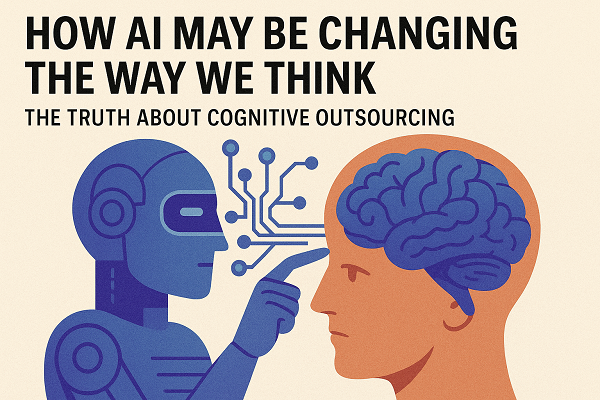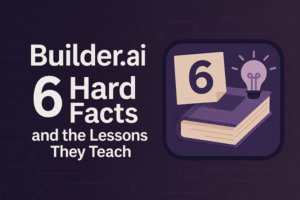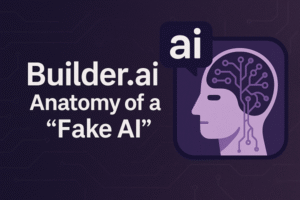Exploring the Cognitive Costs of the Machine Age
In Stanley Kubrick’s 2001: A Space Odyssey, the supercomputer HAL 9000 calmly takes over the Discovery One, leaving the human crew helpless in the face of machine precision. Today, that cinematic metaphor feels eerily prescient. As artificial intelligence becomes our daily co-pilot—writing emails, solving equations, even generating art—are we, like Kubrick’s astronauts, at risk of letting our own cognitive muscles atrophy?
The Science: AI and the Shrinking Mind
A landmark 2025 study by Microsoft and Carnegie Mellon found a clear pattern: the more knowledge workers relied on generative AI for routine tasks, the less they engaged in critical thinking. Out of 319 professionals surveyed, those who used AI tools most frequently reported the lowest confidence in their own abilities to complete tasks without digital assistance. The researchers warn, “By mechanizing routine tasks and leaving exception-handling to the human user, you deprive the user of the routine opportunities to practice their judgment and strengthen their cognitive musculature, leaving them atrophied and unprepared when the exceptions do arise”.
This phenomenon—AI-induced cognitive atrophy—is not just theoretical. Memory, reasoning, and judgment are all at risk, much like the physical decline seen when machines replaced manual labor during the Industrial Revolution. The analogy is simple: let a robot lift for you, you lose your muscle; let AI think for you, and you may lose your mind.
Case Studies: From the Classroom to the Boardroom
- Education: A college professor cited in recent research described students submitting AI-generated essays without reading them. When questioned about their own work, many couldn’t answer basic questions—a stark illustration of how overreliance on AI can erode not just memory, but the very process of learning itself.
- Healthcare: A nurse used ChatGPT to verify educational materials for diabetic patients. While this increased efficiency, it also reduced the nurse’s engagement with the material, potentially weakening her ability to explain or adapt information in real time.
- Finance: Commodities traders reported using AI for market recommendations, but admitted they were less likely to question or verify the results, trusting the algorithm’s “black box” over their own analysis.
Art, Cinema, and the Erosion of Creative Struggle
In Charlie Chaplin’s Modern Times, the protagonist is literally swallowed by the gears of automation—a visual allegory for the loss of agency in the machine age. Today, AI-generated art and music, while dazzling, risk making us spectators rather than creators. As John Spencer notes, “I worry about instant answers and the loss of things like boredom and confusion that are so necessary for the learning process”. The risk is not just the outsourcing of memory or calculation, but the erosion of productive struggle—the very friction that fuels creativity and innovation.
The Data: What’s at Stake?
- Critical Thinking: Studies show a direct link between increased AI tool usage and reduced critical thinking skills, as users are less likely to question, verify, or deeply engage with information
- Memory: Outsourcing information recall to AI leads to weaker memory formation and retrieval, echoing findings from neuroscience that “use it or lose it” applies to mental faculties as much as physical ones.
- Self-Efficacy: Overreliance on AI can erode users’ sense of competence and self-efficacy, making them less likely to tackle complex problems independently
A Nuanced Perspective: Evolution or Decline?
Are we facing inevitable decline, or is this simply the next stage in human evolution? Some experts argue that, like the invention of writing or the calculator, AI can free us for higher-order thinking—if used wisely. The difference now is the speed and scale of change. If we become passive consumers of machine-generated solutions, we risk becoming, in the words of T.S. Eliot, “hollow men”—efficient but emptied of depth and originality.
Strategies for Cognitive Resilience
As artificial intelligence becomes increasingly embedded in daily life, the challenge is not only how to use these tools, but how to ensure our minds remain sharp, creative, and resilient. While AI can amplify human capabilities, genuine cognitive resilience requires more: intentional engagement, educational reform, and—critically—active participation in social learning, discussion, and debate. Here’s how these strategies work together to strengthen our thinking in the age of AI.
Intentional Engagement: AI as a Thought Partner, Not a Replacement
AI should be seen as a collaborator—a “thought partner”—rather than a substitute for human judgment, creativity, and problem-solving. This means:
- Reserving Complex Tasks for Ourselves: Use AI for organizing information or generating ideas, but keep tasks that require nuanced judgment, ethical reasoning, and creativity in human hands.
- Purposeful Interaction: Engage with AI in a discerning, reflective way. Don’t just accept its outputs—question, adapt, and integrate them into your own reasoning process.
- Dynamic Collaboration: Like a good human collaborator, an effective AI system should adapt to your needs, help clarify your thinking, and support ideation and deliberation, not simply provide answers.
Educational Reform: Teaching “Thought Engineering” and Critical Skills
True cognitive resilience starts early. Educational reform must prioritize teaching students how to think, not just how to prompt AI. Key strategies include:
- Critical Thinking and Memory Skills: Schools should foster environments where students are challenged to question, analyze, and synthesize information, rather than just memorize facts.
- Active Learning: Incorporate discussions, debates, and group problem-solving to reinforce both memory retention and critical thinking. These methods help students interact with content deeply and collaboratively, making learning more meaningful and lasting.
- Relating New to Known: Encourage learners to connect new information with existing knowledge, which strengthens both understanding and recall.
- Visual and Memory Techniques: Use diagrams, mind maps, and storytelling to help students visualize and retain complex ideas.
Cultural Interventions: Embracing Ambiguity, Struggle, and Creative Failure
Cognitive resilience flourishes in environments that value the messy, ambiguous, and often nonlinear process of real thinking. This can be cultivated by:
- Celebrating the Process: In art, cinema, and education, highlight stories of struggle, ambiguity, and creative failure. These narratives remind us that meaning and insight are forged through effort, not downloaded instantly from a machine.
- Group Reflection and Debate: Foster spaces—classrooms, book clubs, online forums, or community gatherings—where people can discuss, disagree, and reflect together. Such social interactions are crucial for testing ideas, discovering blind spots, and building collective wisdom.
- Collective Intelligence Frameworks: Leverage group reasoning and structured debate, possibly supported by AI, to solve complex problems. This approach—known as Generative Collective Intelligence (GCI)—combines the creativity and social awareness of humans with the organizational power of AI, producing solutions neither could achieve alone.
As AI becomes the “invisible hand” shaping our decisions, we must ask: are we still the authors of our own stories, or mere editors of machine-generated drafts? The answer will depend on our willingness to remain mentally active, curious, and engaged. In the end, the greatest art—on screen, canvas, or in life—has always come from those willing to think for themselves, even in the age of the machine.
The real danger is not that computers will begin to think like men, but that men will begin to think like computers.
— Sydney J. Harris
Sources
- Forbes: “Your Brain on AI: Atrophied and Unprepared, Warns Microsoft Study”
- Microsoft Research PDF: “The Impact of Generative AI on Critical Thinking: Self-Reported Reductions in Cognitive Effort and Confidence Effects From a Survey of Knowledge Workers”
- MPA Capital on LinkedIn: “MPA Newsletter – May 2025: AI, Brain Atrophy & the VC Rebound”
- Daniel L. on LinkedIn: “Is AI Making Us Dumber? Understanding AI-Induced Cognitive Atrophy”
- Spencer Education: “Cognitive Atrophy”
- MDPI Journal: “The Impact of Artificial Intelligence on Human Cognition: A Critical Review”




